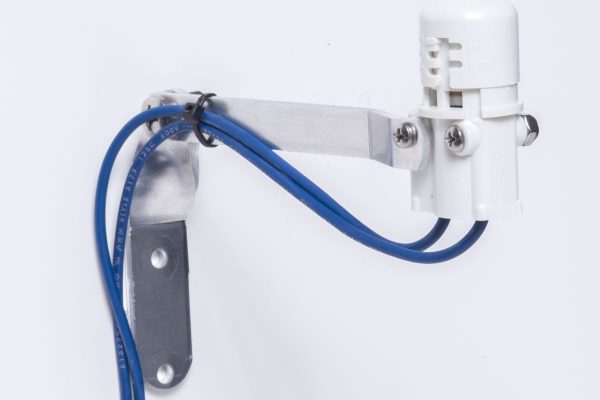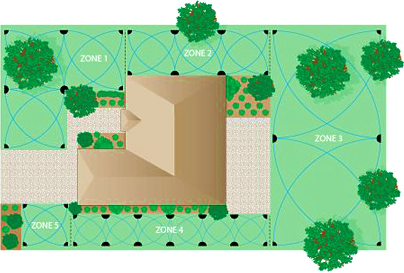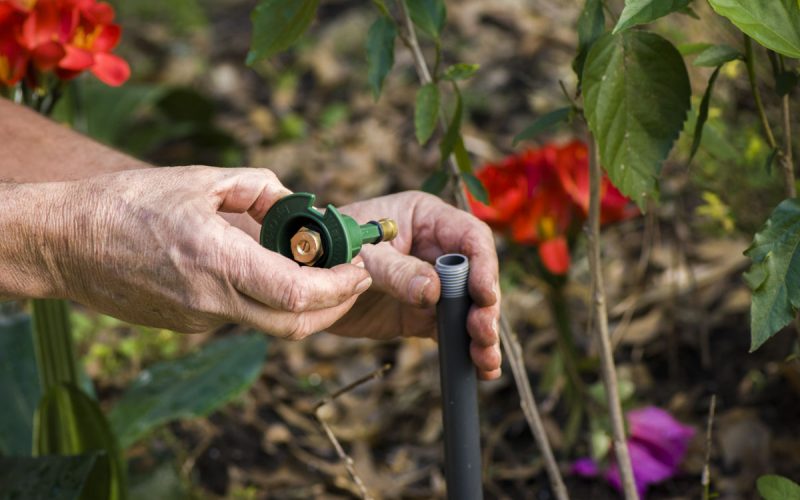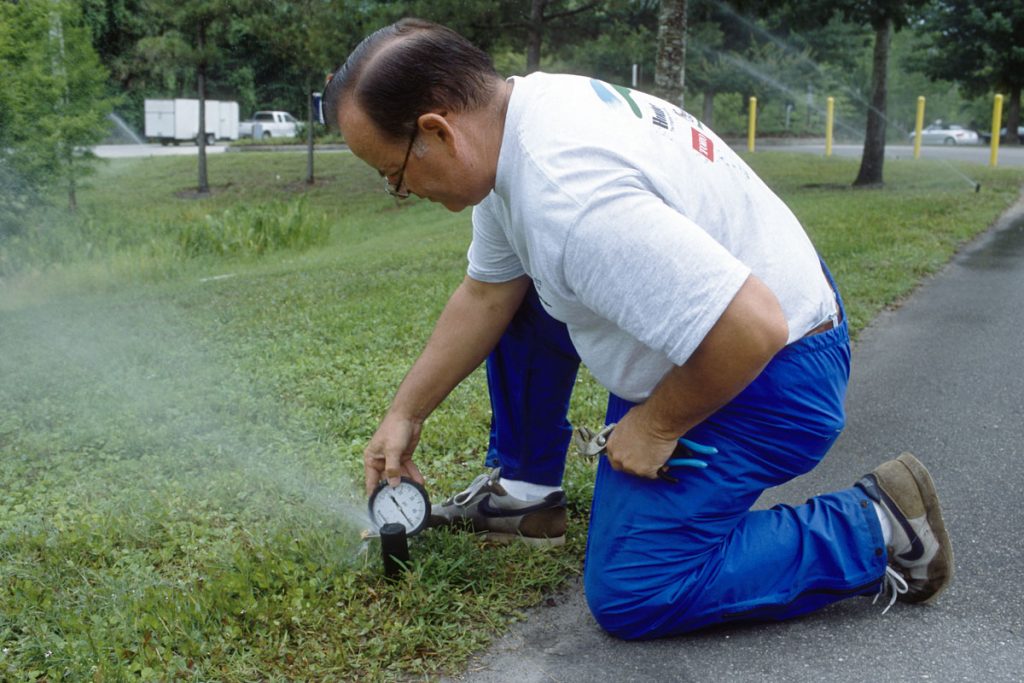Irrigation system maintenance
We can have a tremendous impact on the amount of water we use outdoors by using well-designed irrigation systems and performing regular maintenance to keep them functioning properly.
An automatic irrigation system is set for a predetermined time of day and days of the week. Make sure it is set to follow the watering restrictions. Learn how to operate your system. Check timing devices regularly to make sure they are operating properly. Watch for broken or misdirected sprinklers. During extended periods of rainy weather, irrigation systems should be turned off.
Install sprinklers that are the most water efficient for each use. Rotors and spray heads are good for turf areas, but don’t use both in the same zone. For even distribution, flow rates must be consistent throughout the zone. In planting beds, use micro-irrigation, which includes drip and soaker hoses. Also, use spray heads designed for planting beds. Position the sprinkler to water only the lawn and shrubs, not paved areas.
Maintain your irrigation system. Watch for broken or misdirected sprinklers. Check for leaks and clogged spray heads. Soft, wet spots around the sprinkler could indicate a leak is being absorbed into the ground.
Florida law requires that all automatic irrigation systems installed after May 1991 have a functioning rain sensor shut-off switch. This switch overrides the automatic irrigation system’s cycle when a preset amount of rain has fallen. The switch can be adjusted for different amounts of rainfall. To ensure proper functioning, the sensor should not be installed in an area that is blocked by roof overhangs, bushes or trees. Check regularly to make sure the system is working properly.
Backflow prevention devices are also necessary to prevent water from flowing back into the water main, which can contaminate drinking water.

With Florida’s irrigation laws continually being updated, you should consult with or hire a certified professional to design and install an irrigation system. Certified professionals can be found by contacting organizations such as:
General design tips
A landscape and an irrigation system should be designed so that they work well together. This means putting your plants in “irrigation zones,” allowing for a system design that will deliver the appropriate amount of water to individual planting beds or turf areas.
You should:
- Keep non-turf plants confined to planting beds.
- Group together plants that have similar moisture needs.

Irrigation zones
For efficient irrigation, zones are critical. Each irrigation zone should be composed of the same kind of emitters throughout, be it rotors, spray heads or micro-irrigation. The rate at which different heads deliver water varies, so for even coverage, head types should not be mixed. Also, heads from different manufacturers vary in coverage, so all heads should be the same brand to ensure even coverage.
The term “head-to-head coverage” is used to describe proper placement of sprinkler heads to ensure even water coverage. Essentially, the water from one head should reach the closest neighboring heads.
Use rotors or pop-up spray heads for turf areas, but don’t use both in the same zone.
Other considerations include:
- Use rotors to water large turf areas.
- Use spray heads to water medium- to small-sized turf areas.
- Use micro-irrigation to water planting beds. Because it is a low-volume irrigation technique, micro-irrigation uses less water than rotors and spray heads. Micro-irrigation systems include trickle or drip, micro-sprays (also known as micro-jets) and bubblers.
- Use bubblers to establish trees or large shrubs.

Head placement
Spray head placement is just as important as the type of head used in the various zones of your irrigation system.
Spray heads should rise above properly mowed St. Augustine turf. Use six-inch pop-up riser extensions and periodically raise spray heads above grass beds.

Pressures and piping
Adequate pressure must be factored through the entire system, from the water source to the last head on the line. Increases in pressure can occur by improper design, such as by using pipe that is too small. Too much pressure in pipes can cause leaks by wearing down pipes and fittings.
Low pressure is apparent when heads emit large droplets, which can cause erosion and runoff. Too much pressure can result in heads misting, allowing water to drift away. Pressure-regulated heads or valves can reduce high pressure issues.
Irrigation controller
Most irrigation system timers, also known as controllers, allow a great level of control over watering schedules but can also be responsible for a lot of waste if not programmed correctly. Familiarize yourself with your timer’s functions using the instruction manual it came with. Often, controllers also have directions on the inside of the cover panel or online videos to explain their functioning.
Program elements
Timers generally have three criteria that need to be set: watering days, start time and watering duration.
What days the system waters will need to be changed seasonally.
“Start times” refer to the time of day the first zone will begin watering, followed by the other zones in sequence. Remember to set your system to operate before 10 a.m. or after 4 p.m.
Watering duration
The number of minutes that each zone runs — depends on the type of head used in each zone. Three-quarters of an inch of water is enough to replenish the grass.
Moderate amounts of water can create a healthy, drought- and stress-tolerant lawn. Applying no more than three-quarters of an inch of water is enough to replenish the grass.
Generally:
- Rotor zones set between 45 and 60 minutes apply about three-quarters to an inch of water.
- Zones with spray heads set at 20 to 35 minutes generally apply the same amount.
- For newly installed planting beds, set micro-irrigation zones for 60 minutes twice a week for 30 days. Then cut back to once a week until plants are established, which will take no more than another month or two, depending on weather conditions. Then water only as needed.
Other considerations
The following factors should also be considered when scheduling irrigation systems:
- During extended periods of rainy weather, irrigation systems should be turned off.
- Irrigation controllers have default programs that take over if a set program is lost due to a power outage. On some controllers if the schedule switch is in the “custom” mode, it will default to watering every day. Reset program after a power outage.
For an irrigation system to function efficiently, regular maintenance is required. Just as you routinely rotate the tires and change the oil of your car, you must also inspect and adjust your irrigation system for it to work properly. You should:
- Turn the system on occasionally during daylight hours to observe the heads during irrigation and to check for broken or misdirected spray heads.
- Periodically raise rotors and spray heads above grass beds because foot and mower traffic tend to push them into the soil.
- Buy and install riser extensions as ground covers grow or grass thickens at the base. These keep spray heads above grass beds.
- Replace or clean micro-spray heads if they are clogged.
- Adjust heads so they cover the target area and don’t waste water on tree trunks or sidewalks.
- Clean micro-irrigation filters as needed. Filtration is necessary to prevent spray emitters from getting clogged.
- Use only replacement parts produced by the same manufacturer, as different brands often don’t match up correctly.

